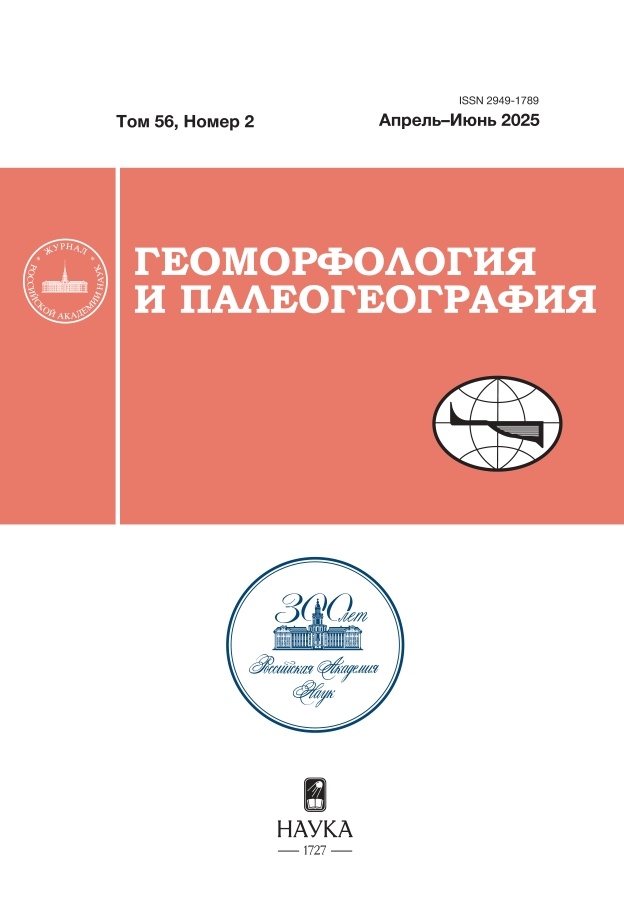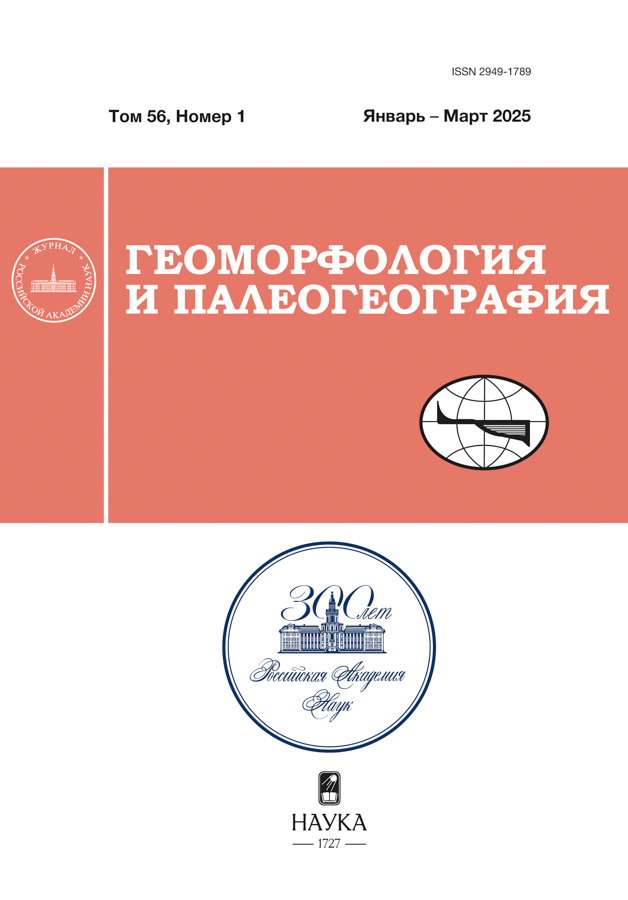Влияние раннехвалынской трансгрессии каспия на строение долины волги и ее притоков (ключевой участок малый караман, саратовская область)
- Авторы: Макшаев Р.Р.1, Матлахова Е.Ю.1, Ткач Н.Т.2, Лобачева Д.М.1, Лысенко Е.И.1, Ткач А.А.1
-
Учреждения:
- Московский государственный университет имени М.В. Ломоносова, географический факультет
- Геологический институт РАН
- Выпуск: Том 56, № 1 (2025)
- Страницы: 116-129
- Раздел: Каспий в плейстоцене: эволюция природной среды и человек
- URL: https://ruspoj.com/2949-1789/article/view/686621
- DOI: https://doi.org/10.31857/S2949178925010069
- EDN: https://elibrary.ru/DNXQPH
- ID: 686621
Цитировать
Полный текст
Аннотация
Раннехвалынская трансгрессия Каспия является одной из крупнейших в позднем плейстоцене, в связи с этим в долине Волги и ее притоков формировался обширный палеоэстуарий. Формирование террас в речных долинах региона, таким образом, тесно связано с трансгрессивно-регрессивной динамикой Каспийского моря. В данной работе рассматривается ключевой участок долины р. Малый Караман (левый приток Волги), его морфология и строение, литологический состав и возраст отложений, слагающих террасы, для установления влияния раннехвалынской трансгрессии Каспия на строение долины.
Ключевые слова
Полный текст
Об авторах
Р. Р. Макшаев
Московский государственный университет имени М.В. Ломоносова, географический факультет
Автор, ответственный за переписку.
Email: radikm1986@mail.ru
Россия, Москва
Е. Ю. Матлахова
Московский государственный университет имени М.В. Ломоносова, географический факультет
Email: radikm1986@mail.ru
Россия, Москва
Н. Т. Ткач
Геологический институт РАН
Email: radikm1986@mail.ru
Россия, Москва
Д. М. Лобачева
Московский государственный университет имени М.В. Ломоносова, географический факультет
Email: radikm1986@mail.ru
Россия, Москва
Е. И. Лысенко
Московский государственный университет имени М.В. Ломоносова, географический факультет
Email: radikm1986@mail.ru
Россия, Москва
А. А. Ткач
Московский государственный университет имени М.В. Ломоносова, географический факультет
Email: radikm1986@mail.ru
Россия, Москва
Список литературы
- Бадюкова Е.Н. (2021). Колебания уровня Каспийского моря в неоплейстоцене (была ли ательская регрессия?). Океанология. Т. 61. № . 1. С. 320–329. https://doi.org/10.31857/S0030157421010020
- Безродных Ю.П., Делия С.В., Романюк Б.Ф. и др. (2015). Новые данные по стратиграфии верхнечетвертичных отложений Северного Каспия. Доклады академии наук. Т. 462. № 1. С. 95–99. https://doi.org/10.7868/S0869565215130162
- Брицина М.И. (1954). Распространение хвалынских шоколадных глин и некоторые вопросы палеогеографии Северного Прикаспия. Труды Института географии АН СССР. Т. 62. С. 5–27.
- Васильев Ю.М. (1961). Антропоген Южного Заволжья. Труды геологического института АН СССР. Вып. 49. 128 с.
- Геологическая карта СССР. Серия Средневолжская, масштаб: 1:200 000, серия: Средневолжская, лист M-38-V. (1967). Под ред. А. Я. Дубинского. Ленинград: Средневолжское территориальное геологическое управление. 1 л.
- Горецкий Г.И. (1966). Формирование долины р. Волги в раннем и среднем антропогене. М.: Наука, 412 с.
- Государственная геологическая карта Российской Федерации. Издание второе. Средневолжская серия. Карта плиоцен-четвертичных образований, масштаб: 1:200 000, лист N-39-XXV (Сызрань). (2017). Под. ред. В. П. Кирикова. СПб: ВСЕГЕИ. 1 л.
- Квасов Д.Д. (1975). Позднечетвертичная история крупных озер и внутренних морей Восточной Европы. Л.: Наука. 278 с.
- Курбанов Р.Н., Беляев В.Р., Свистунов М.И. и др. (2023). Новые данные о возрасте раннехвалынской трансгрессии Каспийского моря. Известия РАН. Серия географическая. Т. 87. № 3. С. 403–419. https://doi.org/10.31857/S2587556623030081
- Макшаев Р.Р., Ткач Н.Т. (2023). Хронология хвалынского этапа развития Каспия по данным радиоуглеродного датирования. Геоморфология и палеогеография. № 1. С. 37–54. https://doi.org/10.31857/S0435428123010108
- Матлахова Е.Ю. (2014). Валдайский террасовый комплекс в речных долинах центра Восточно-Европейской равнины. Автореф. дис. … канд. геогр. наук. М.: МГУ. 26 с.
- Матлахова Е.Ю., Украинцев В.Ю., Панин А.В. (2021). История развития долины р. Мокши в конце позднего плейстоцена. Геоморфология. № 3. C. 105–115. https://doi.org/10.31857/S043542812103007X
- Москвитин А.И. (1958). Четвертичные отложения и история формирования долины р. Волги в ее среднем течении. Труды ГИН АН СССР. Вып. 12. 210 с.
- Москвитин А.И. (1962). Плейстоцен Нижнего Поволжья. Труды ГИН АН СССР. Вып. 64. 264 с.
- Обедиентова Г.В., Губонина З.П. (1962). О хвалынском веке в пределах Нижнего Поволжья. В сб.: Вопросы палеогеографии и геоморфологии бассейнов Волги и Урала. М.: Изд-во АН СССР. С. 144–174.
- Обедиентова Г.В. (1977). Эрозионные циклы и формирование долины Волги. м.: Наука. 242 с.
- Ресурсы поверхностных вод СССР. Т. 12. Нижнее Поволжье и Западный Казахстан. Вып. 1. (1971). Под ред. В.Г. Водогрецкого. Л.: Гидрометиздат. 419 с.
- Свиточ А.А. (2014). Большой Каспий: строение и история развития. М.: Изд-во Мос. ун-та. 272 с.
- Свиточ А.А. (2000). Нижнее и юг Среднего Поволжья в плейстоцене. Геоморфология. № 1. С. 29–40.
- Свиточ А.А., Макшаев Р.Р., Ростовцева Ю.В. и др. (2017). Шоколадные глины Северного Прикаспия. М.: Географический факультет МГУ. 140 с.
- Свиточ А.А., Парунин О.Б. (2000). Радиоуглеродный возраст палеогеографических событий позднего плейстоцена-голоцена Северного Прикаспия. Доклады академии наук. Т. 371. № 4. С. 504–506.
- Свиточ А.А., Янина Т.А. (1997). Четвертичные отложения побережий Каспийского моря. м.: РАСХН. 267 с.
- Свиточ А.А., Янина Т.А., Хоменко А.А., Новикова Н.Г. (2009). Хвалынские отложения Маныча. Доклады академии наук. Т. 428. № 1. С. 70–74.
- Седайкин В.М. (1988). Опорные разрезы четвертичных отложений Северо-Западного Прикаспия. Деп. ВИНИТИ. № 1594-В-88. 190 с.
- Семиколенных Д.В. (2022). Палеогеография проливов Понто-Каспия в позднем плейстоцене. Автореф. дис. … канд. геогр. наук. м.: ИГРАН. 26 с.
- Федоров П.В. (1957). Стратиграфия четвертичных отложений и история развития Каспийского моря. Труды Геологического института АН СССР. Вып. 10. 297 с.
- Украинцев В.Ю. (2022). Следы мощного речного стока в долинах рек бассейна Волги в поздневалдайскую эпоху. Геоморфология. № 1. С. 26–34. https://doi.org/10.31857/S0435428122010126
- Четвертичные отложения, рельеф и неотектоника Нижнего Поволжья. (1978). Под ред. А.В. Вострякова, Н.И. Кузнецовой, С.А. Макарова. Саратов: Изд-во Саратовского ун-та. 184 с.
- Янина Т.А. (2012). Неоплейстоцен Понто-Каспия: биостратиграфия, палеогеография, корреляция. М.: Изд-во Моск. ун-та. 264 с.
- Янина Т.А., Свиточ А.А., Курбанов Р.Н. и др. (2017). Опыт датирования плейстоценовых отложений Нижнего Поволжья методом оптически стимулированной люминесценции. Вестник Московского университета. Серия 5. География. № 1. С. 20–28.
- Bronk Ramsey C. (2009). Bayesian analysis of radiocarbon dates. Radiocarbon. Vol. 51. Iss. 1. P. 337–360. https://doi.org/10.1017/S0033822200033865
- Kurbanov R.N., Buylaert J.P., Stevens T. et al. (2022). A detailed luminescence chronology of the Lower Volga loess-palaeosol sequence at Leninsk. Quat. Geochronology. Vol. 73. 101376. https://doi.org/10.1016/j.quageo.2022.101376
- Kurbanov R.N., Murray A.S., Yanina T.A. et al. (2021). First optically stimulated luminescence ages of the early khvalynian Caspian Sea transgression in the lower Volga. Boreas Vol. 50. No. 1. P. 134–146. https://doi.org/10.1111/bor.12478
- Makshaev R.R., Svitoch A.A. (2016). Chocolate clays of the northern Caspian Sea region: distribution, structure, and origin. Quat. Int. Vol. 409. P. 44–49. https://doi.org/10.1016/j.quaint.2015.07.018
- Molod’kov A., Bitinas A. (2006). Sedimentary record and luminescence chronology of the Lateglacial and Holocene aeolian sediments in Lithuania. Boreas. Vol. 35. P. 244–254. https://doi.org/10.1111/j.1502-3885.2006.tb01154.x
- Pánek T., Korup O., Miná J., Hradecký J. (2016). Giant landslides and highstands of the Caspian Sea. Geology. Vol. 44. P. 939–942. https://doi.org/10.1130/G38259.1
- Panin A., Matlakhova E. (2015). Fluvial chronology in the East European Plain over the last 20 ka and its palaeohydrological implications. Catena. Vol. 130. P. 46–61. https://doi.org/10.1016/j.catena.2014.08.016
- Reimer P J., Austin W.E.N., Bard E. et al. (2020). The IntCal20 northern Hemisphere radiocarbon age calibration curve (0–55 cal ka BP). Radiocarbon. Vol. 62. Iss. 4. P. 725–757. https://doi.org/10.1017/RDC.2020.41
- Sidorchuk A.Yu., Ukraintsev V.Yu., Panin A.V. (2021) Estimating Annual Volga Runoff in the Late Glacial Epoch from the Size of River Paleochannels. Water resources. Vol. 48. No. 6. P. 864–876. https://doi.org/10.1134/S0097807821060178
- Stuiver M., Reimer P.J., Reimer R.W. (2021). CALIB8.1. http://calib.qub.ac.uk/calib/ (дата обращения: 10.10.2024).
- Svitoch A.A., Makshaev R.R. (2020). Incompleteness of the geological record in Middle-Upper Pleistocene key sections of the Northern Caspian Lowland. Quat. Int. Vol. 540. P. 78–96. https://doi.org/10.1016/j.quaint.2019.04.030
- Svitoch A.A., Markova A.K., Yanina T.A. (2021). Stratigraphy and the small mammal fauna of the Late Pleistocene sections in the south of the middle reaches of the Volga River. Quat. Int. Vol. 605–606. р. 93–107. https://doi.org/10.1016/j.quaint.2020.12.001
- Zastrozhnov A., Danukalova G., Golovachev M. et al. (2020). Biostratigraphical investigations as a tool for paleoenvironmental reconstruction of the Neopleistocene (Middle-Upper Pleistocene) at Kosika, Lower Volga, Russia. Quat. Int. Vol. 540. р. 38–67. https://doi.org/10.1016/j.quaint.2018.11.036
Дополнительные файлы















